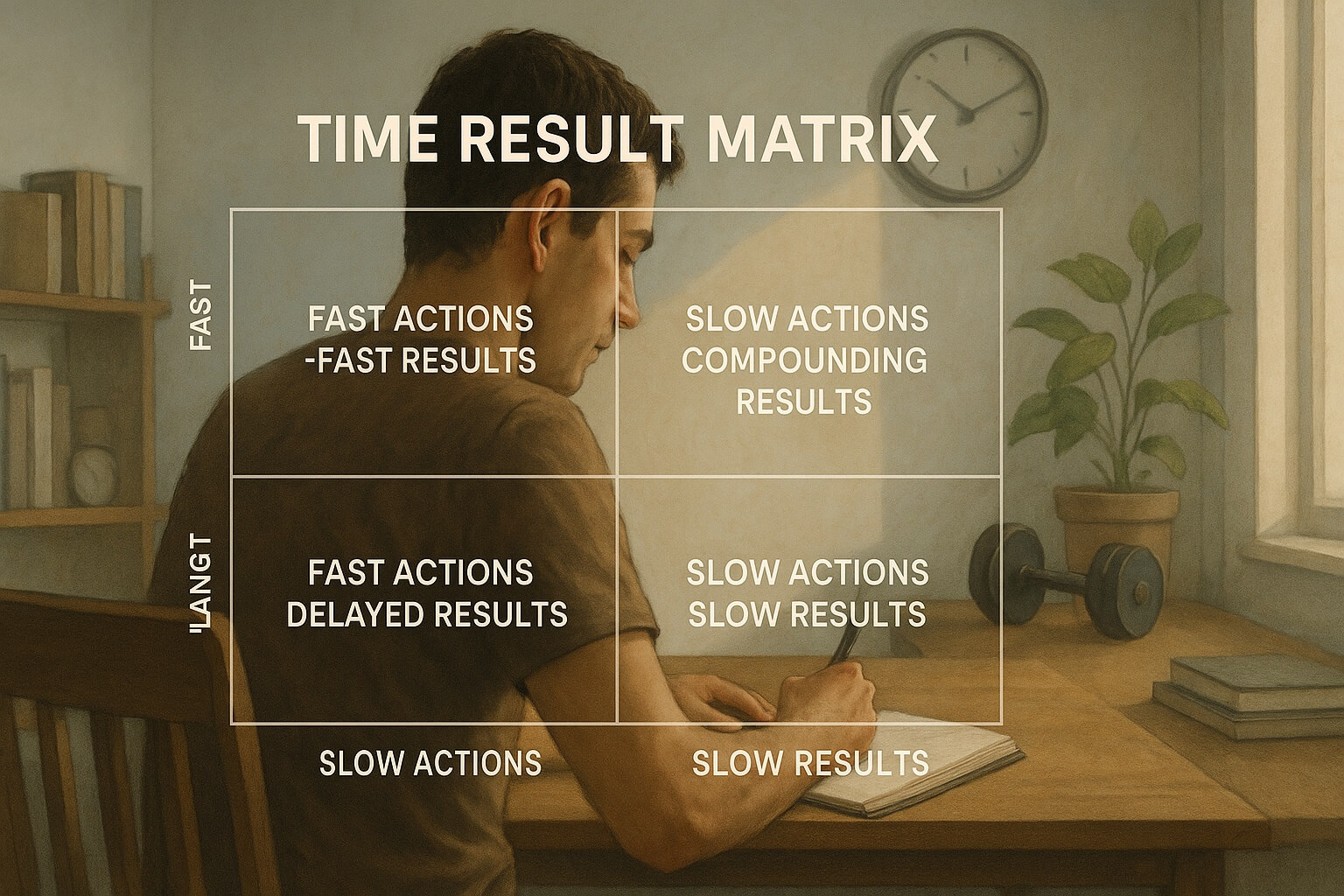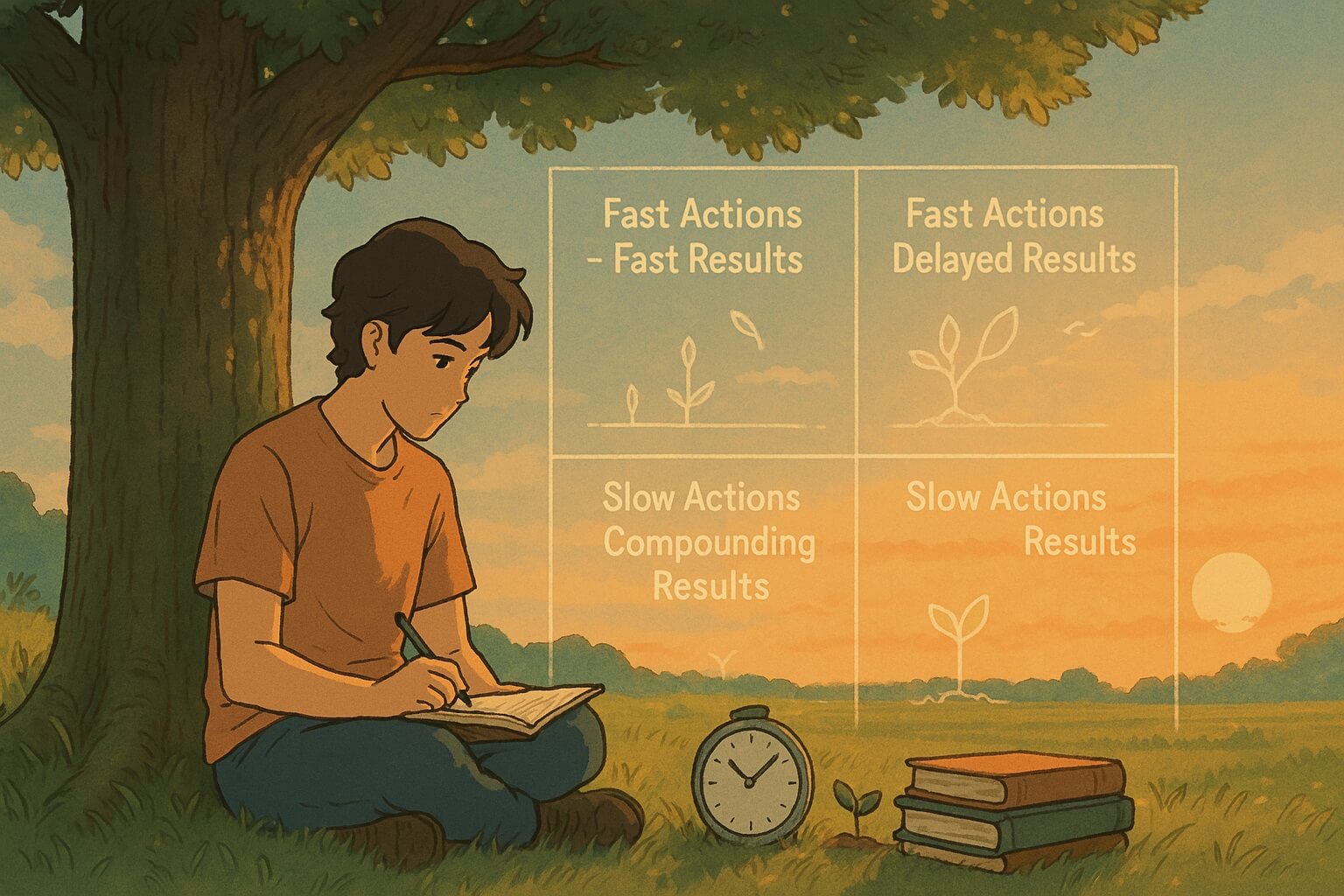
People often feel stuck when their hard work doesn’t immediately show results. It’s frustrating to give consistent effort and feel like nothing is changing. This isn’t just a personal struggle—it’s a common issue across education, careers, relationships, and health. The real question is: are you looking at the whole picture when you expect results?
Most outcomes rely on two key factors: time and effort. But we often overlook the fact that results don’t depend solely on your input. They also depend on when others respond, systems align, or conditions mature. The Time Result Matrix, a model that explains how actions and timing shape outcomes, helps us better understand this.
Let’s say you're studying hard, applying for jobs, building a habit, or working on a relationship. You’re giving your time, but if the response from the world is delayed or mismatched, the result doesn't appear. This is why results are almost always two-sided.
Understanding this matrix doesn’t just clarify why some goals take longer—it helps build realistic expectations, lowers stress, and gives you the confidence to keep going when results aren’t visible yet. In this article, you’ll see how this model applies across areas of life, backed by expert insights, research data, and relatable real-world examples.
Table of Content
- What Is the Time Result Matrix?
- The Two Dimensions: Time and Action
- Why External Response Matters
- Time Result Matrix Quadrants
- Patterns in Human Behavior That Affect Results
- Why the Brain Misreads Time and Effort
- When People Misuse the Matrix
- Practical Uses of the Matrix in Daily Life
- What Research Tells Us
- Planning with the Time Result Matrix
- Why It Pays to Know This Model
- Conclusion: Why Results Are Two-Sided
- FAQs
What Is the Time Result Matrix?
The Time Result Matrix is a tool to help visualize how your effort interacts with time to produce different outcomes. It's based on a simple idea: what you do and how long you keep doing it will shape the result. But the catch is that outcomes also depend on factors outside your control—external timing, responses, opportunities.
Think of it like planting seeds. Your job is to water them. But whether they sprout tomorrow or next month depends on the weather, soil, and season.

The Two Dimensions: Time and Action
How Time Works in the Matrix
Time isn’t just the number of days that pass. It’s how long you stay consistent. The longer the timeline, the more room there is for your efforts to build. That’s why small daily actions often beat one-time efforts. Most meaningful results need time to show up.
How Actions Influence Results
Action is the controllable half. Whether you work out, save money, or learn a skill, it’s your input. But without sustained action over time, even smart strategies fail.
Result = Times You Give + Times They Give
There’s one major detail most people miss. Results don’t only depend on your effort. They also depend on others—when they’re ready to listen, respond, or collaborate.
Why External Response Matters
You might be prepared for an opportunity, but there has been no result if the other side isn't. This applies to jobs, relationships, teaching, sales, and more. Your preparation needs to match their timing.
Personal and Professional Examples
-
A student applies for a scholarship. Her preparation is strong, but the decision depends on when the committee reviews and what they want.
-
A person expresses interest in a relationship, but the other person is not emotionally ready.
-
A freelancer submits proposals daily, but companies reply based on their hiring cycle.
Your effort matters—but so does their timing.
Time Result Matrix Quadrants
The matrix has four major quadrants, depending on whether time and action are high or low.
Fast Actions, Fast Results
This is rare but possible. You act, and the world responds quickly. Think of preparing for a weekly quiz—you study today and score well tomorrow.
Slow Actions, Slow Results
Minimal effort, long gaps. You only exercise once a week and wonder why there’s no change. This quadrant gives poor returns.
Fast Actions, Delayed Results
Common and frustrating. You do the right things, but results don’t come fast. This is when many people quit. But in reality, things are working—you just can't see them yet.
Slow Actions, Compounding Results
Small efforts repeated over time lead to strong results. Daily meditation, reading 10 pages a day, or saving a few dollars regularly eventually lead to significant improvements.
Case Study: Academic Performance Over a Semester
A student starts studying 30 minutes a day from the first week of the semester. After the first test, scores are average. Friends who crammed a day before scored higher. But by the final exams, the daily-practice student performs better. Less stress, stronger understanding, and long-term retention. That’s the compounding effect of the matrix.
Patterns in Human Behavior That Affect Results
Procrastination Pushes Results Further
Delaying action means starting the clock late. If you put off applying, practicing, or preparing, you shrink the window where results can happen.
Consistency Beats Intensity
A short burst of action won’t match steady effort. One day of hard work can’t replace 30 days of small progress. Think of brushing teeth once for 30 minutes vs. daily brushing.
Why the Brain Misreads Time and Effort
The brain wants fast feedback. That’s why we like apps that reward us instantly. But most valuable results—health, learning, skills—take time. Psychologists call this “temporal discounting.” We value short-term rewards more than long-term ones.
Understanding the matrix helps fight this bias. It reminds us that slow feedback doesn’t mean failure.
When People Misuse the Matrix
Many expect fast rewards. This creates unrealistic goals and burnout. Here are common false beliefs:
-
"If I don’t see results in a week, it’s not working."
-
"Others got faster results, so I must be behind."
-
"If I try harder now, I should get results faster."
These ideas ignore the fact that your efforts may need more time—or that external responses aren’t instant.
Practical Uses of the Matrix in Daily Life
Education
Daily studying vs. last-minute cramming. The matrix favors consistent learners.
Career Growth
Building a resume or portfolio now may not show results until an opening appears.
Health and Fitness
One gym session won’t change your body. But 3 sessions a week for 6 months will.
Relationships
You may try to fix things with one conversation. But trust is built over repeated effort.
Finance
Saving $10 every week grows slowly, then faster. Compounding works best with time.
What Research Tells Us
Experts back this model. Daniel Kahneman’s work on delayed thinking, Angela Duckworth’s studies on grit, and James Clear’s habit research all show that results take time and consistency.
-
Kahneman: Fast thinking often leads to errors; slow, deliberate effort pays off.
-
Duckworth: Passion + perseverance over time beats natural talent.
-
Clear: Identity-based habits reshape behavior long-term.
Reports from OECD and APA confirm that student success, emotional health, and performance growth all depend on long-term strategies rather than instant effort.
Planning with the Time Result Matrix
Use this matrix when setting personal or academic goals. Here’s how:
-
Break big goals into daily actions.
-
Expect a delay between effort and result.
-
Track consistency, not outcome.
-
Avoid comparison with people in different timelines.
Why It Pays to Know This Model
Once you get how this works, you stop feeling like you’re failing just because results are late. You start trusting your process and recognizing small wins.
-
You’ll build patience.
-
You’ll stay motivated longer.
-
You’ll avoid burnout from over-pushing.
Mistakes to Avoid
-
Expecting others to respond on your timeline.
-
Judging yourself by someone else’s pace.
-
Giving up right before results start showing.
Making Peace With Patience
Big rewards often come after long silence. You’re building skills, systems, and support even when nothing seems to be happening. This is the quiet phase where success takes root.
Keep watering the seed. When your time meets the right response, growth becomes visible.
Conclusion: Why Results Are Two-Sided
The Time Result Matrix reminds us that effort is only one part of the story. Timing matters. Response matters. Results come when both your input and the external world meet at the right moment.
Don’t let delays convince you that your work isn’t enough. You might be one response away from a breakthrough. Keep showing up, keep doing the work, and let time do its part.
FAQs
1. What is the main idea behind the Time Result Matrix?
It shows that outcomes depend on both your effort and when external responses or conditions align with that effort.
2. Why do some people get fast results and others don’t?
Different timelines, opportunities, and responses. The matrix explains how not all effort pays off instantly.
3. How can I stay patient when progress feels slow?
Track what you can control—your daily actions. Expect results to take time. Trust the process.
4. Is it bad to expect quick results?
Not bad—but risky. It creates false pressure. Better to expect delayed success and be surprised by fast wins.
5. Can this matrix be used for team projects or leadership roles?
Yes. It’s useful wherever input and timing affect outcomes—business, teaching, mentoring, or collaboration.





